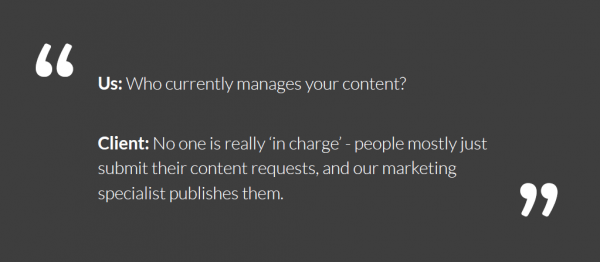Let’s face it: Content governance is hard. It requires a great commitment to long-term strategy and a willingness to insulate your content from the vagaries of corporate pressure. But it is worth it.

Your content is a key corporate asset. Your content strategy establishes the direction to ensure that your key corporate asset will meet your business objectives, and content governance is an integral aspect of that strategy. Governance sets the policies and standards that ensure your organization adheres to your strategy, responds to changes in user and market needs, and engages users with content that’s meaningful across diverse channels, formats, and media. Let me reiterate – content is a corporate asset. Treat it like one.
Characteristics of a Good Content Governance Framework
1. Decide Who Gets to Make the Calls
Establish a governing body or clear executive ownership. Content governance doesn’t happen by accident. It requires a committed group, such as a steering committee, that is willing to enforce strategic decisions about what content should be included and how.
2. Embrace a Set of Criteria for Assessing Content
Avoid adding content based on the whims of individuals—you’ll just end up with a “junk drawer” of content that doesn’t serve your business or your users. Content without clear purpose gets in the way of your objectives.
3. Decide How to Decide
Establish a process for requesting that new content be added or substantially revised. Require that new content requests are critically evaluated and are consistent with the framework or criteria you’ve established for the site. Know when to involve SMEs and when it is a call for the steering committee or marketing experts.
4. Determine Who Will Review and Who Will Approve
Decide on the level of approval required by different types of content. This will be a challenge in organizations where each silo is used to making the decisions about what content goes where, but this is critical to ensuring that all your content—from blog posts to CTAs to videos—are consistent with your objectives. A few tips:
- Always require one level of review. At a minimum, every piece of content should be reviewed for accuracy, voice, tone, and brand consistency.
- Require a greater level of scrutiny for any content that positions high-interest or mission-critical content. Content that introduces new products, services, approaches, as well as thought leadership, all requires more scrutiny.
- Identify content that requires legal/regulatory review. Health plans, financial service agreement details, “the fine print”—all of those need to go through the legal review.
5. Determine the Workflow
Establish a process for review and approval of the content prior to launch, preferably including QA. QA is more than just eyeballing the content to make sure it looks okay. It is checking all aspects of the content and functionality (and that means EVERY. SINGLE. LINK.). Hint: Many content management systems will allow you to automate the workflow.
6. Establish a Review Cycle
Assess all content to determine how frequently it needs to be reassessed for relevancy and accuracy. Content falls into these buckets:
- Evergreen – It will be around forever, won’t change, and doesn’t need to be re-evaluated. Evergreen content is often blog posts and press releases. Note: You may want to consider establishing a process for creating redirects to newer content after a certain number of years.
- Scheduled Review – Some content should be re-evaluated on a regular cycle—such as every six months—to make sure it is still relevant and accurate and doesn’t make your company look dated.
- Event-Based Review – Review of some content will be date-based (e.g., school lunch information should be updated every August, old health plan summaries should be purged when they are no longer active, etc.).
7. Document the Process
Take the time to document your governance process. Good documentation makes it so much easier to be consistent—and to socialize it to the rest of the company.
8. Roll it Out
Socialize the process to the company. People and areas of the organization that are used to being able to put anything they want only won’t like the new process at first. Tell them why it is important.
Sounds hard, doesn’t it? But it is so important to put good content governance frameworks in place, because the risks of not doing so are so big. Risks include damage to your brand; compliance, regulatory, and legal problems; and loss of customers and market share. Ensuring good, strategic management of this important corporate asset is just good business.
